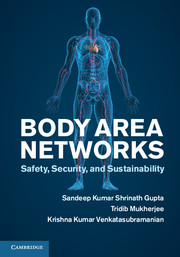Book contents
7 - Implementation of BANs
Published online by Cambridge University Press: 05 April 2013
Summary
BANs are used in several smart and context-aware applications such as home-based health care [54], sports health management [142], entertainment [143], and military applications [144]. These applications impose several processing, communication, and storage requirements on the sensors in the BAN. For example, data sensing and storage are extensively required for home-based health care, computation-intensive physiological signal and image processing is required for military and entertainment applications, and online processing and communication of sensed data are used in sports health monitoring. Chapters 2 and 3 describe several BAN applications and their requirements in detail.
Usability issues in BAN, which include the need for easy wearability, infrequent re-charging of the battery, and thermally safe operation, prevent the use of powerful general-purpose processors in BAN sensors. Hence, application-specific developments of sensor platforms are essential for BANs. This has given rise to a plethora of sensor platforms that are being used for several BAN applications. These platforms are heterogeneous and typically limited in their computational, communication, and storage requirements. Processors ranging from powerful Intel xScale to low-power Atmega 128, radios ranging from power-hungry Bluetooth to efficient ZigBee, and storage ranging from 256 kB to 2 GB flash are available in current sensor platforms. Given these diversities in application requirements and sensor-platform capabilities, implementing a BAN application has two dimensions:
(1) choosing or designing a sensor platform that is best suited for a given application and
(2) implementing the given application in the sensor platform with stringent resource limitations.
- Type
- Chapter
- Information
- Body Area NetworksSafety, Security, and Sustainability, pp. 104 - 118Publisher: Cambridge University PressPrint publication year: 2013



